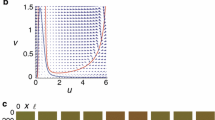Summary
The plasmodium ofPhysarum polycephalum usually migrates coordinately as one whole body even in a complicated environment. By measuring oscillation phenomena in endoplasm and ectoplasm separately during chemotactic process, we studied the mechanism of information processing to achieve such a coordination. (1) The interaction between endoplasmic oscillators was long-range, competitive according to the length of period, and fast (18 cm/min). Ectoplasmic one was short-range. (2) After a partial stimulation of attractant to the organism, the period at the stimulated portion decreased first, and a global phase gradient appeared in endoplasm. Then ectoplasm at the non-stimulated portion was entrained to the endoplasmic pattern, and the migration direction at each part changed in accordance with the phase gradient as a whole body. (3) When the endoplasmic interaction was interrupted, the above coordinated response was not observed. These facts suggest that two-layer coupled oscillator system composed of endoplasm and ectoplasm play important roles for such an information integration.
Similar content being viewed by others
References
Camp WG (1936) A method of cultivating myxomycete plasmodia. Bull Torrey Bot Club 63: 205–210
Coman DR (1940) Additional observations on positive and negative chemotaxis: experiments with a myxomycete. Arch Pathol 29: 220–228
Durham ACH, Ridgway EB (1976) Control of chemotaxis inPhysarum polycephalum. J Cell Biol 69: 218–223
Hejnowicz Z, Wohlfarth-Bottermann KE (1980) Propagated waves induced by gradients of physiological factors within plasmodia ofPhysarum polycephalum. Planta 150: 144–152
Ishigami M, Kuroda K, Hatano S (1978) Dynamic aspects of the contractile system inPhysarum plasmodium: III. Cyclic contraction-relaxation of the plasmodial fragment in accordance with the generation-degeneration of cytoplasmic actomyosin fibrils. J Cell Biol 105: 381–386
Kamiya N (1970) Contractile properties of the plasmodial strand. Proc Japan Acad 46: 1026–1031
— Kuroda K (1958) Studies on the velocity distribution of the protoplasmic streaming in the myxomycete plasmodium. Protoplasma 49: 1–4
Knowles DJC, Carlile MJ (1978) The chemotactic response of plasmodia of the myoxomycetePhysarum polycephalum to sugars and related compounds. J Gen Microbiol 108: 17–25
Kuroda R, Hatano S, Hiramoto Y, Kuroda H (1988) Changes of cytosolic Ca-ion concentration in the contraction relaxation cycle ofPhysarum plasmodia. Protoplasma [Suppl 1]: 72–80
Matsumoto K, Ueda T, Kobatake Y (1986) Propagation of phase wave in relation to tactic responses by the plasmodium ofPhysarum polycephalum. J Theor Biol 122: 339–345
——— (1988) Reversal of thermotaxis with oscillatory stimulus in the plasmodium ofPhysarum polycephalum. J Theor Biol 131: 175–182
Mori Y, Ueda T, Kobatake Y (1987) NAD(P)H oscillation in relation to the rhythmic contraction in thePhysarum plasmodium. Protoplasma 139: 141–144
Nakamura S, Yoshimoto Y, Kamiya N (1982) Oscillation in surface pH of thePhysarum plasmodium. Proc Japan Acad 58 Ser B: 270–273
Tanaka H, Yoshimura H, Miyake Y, Imaizumi J, Nagayama K, Shimizu H (1987) Information processing for the organization of chemotactic behavior ofPhysarum polycephalum studied by micro-thermography. Protoplasma 138: 98–104
Ueda T, Kobatake Y (1982) Chemotaxis in plasmodia ofPhysarum polycephalum, Aldrich HC, Daniel JW (eds) Cell biology ofPhysarum andDidymium, vol 1. Academic Press, New York, pp 111–143
—, Terayama K, Kurihara K, Kobatake Y (1975) Threshold phenomena in chemoreception and taxis in the slime moldPhysarum polycephalum. J Gen Physiol 65: 223–234
—, Matsumoto K, Akitaya T, Kobatake Y (1986) Spatial and temporal organization of intracellular adenine nucleotides and cyclic nucleotides in relation to rhythmic motility inPhysarum plasmodium. Exp Cell Res 162: 486–494
—, Nakagaki T, Yamada T (1990) Dynamic organization of ATP and birefringent fibrils during free locomotion and galvanotaxis in the plasmodium ofPhysarum polycephalum. J Cell Biol 110: 1097–1102
Wohlfarth-Botterman KE (1975) Tensiometric demonstration of endogenous, oscillating contractions in plasmodia ofPhysarum polycephalum. Z Pflazenphysiol 76: 14–27
Yoshimoto Y, Kamiya N (1978) Studies on contraction rhythm of the plasmodial strand. III. Role of endoplasmic streaming in synchronization of local rhythms. Protoplasma 95: 111–121
— Matsumura F, Kamiya N (1981a) Simultaneous oscillations of Ca2+ efflux and tension generation in the permealized plasmodial strand ofPhysarum. Cell Motil 1: 433–443
—, Sakai T, Kamiya N (1981b) ATP oscillation inPhysarum plasmodium. Protoplasma 109: 159–168
Author information
Authors and Affiliations
Rights and permissions
About this article
Cite this article
Miyake, Y., Yano, M. & Shimizu, H. Relationship between endoplasmic and ectoplasmic oscillations during chemotaxis ofPhysarum polycephalum . Protoplasma 162, 175–181 (1991). https://doi.org/10.1007/BF02562560
Received:
Accepted:
Issue Date:
DOI: https://doi.org/10.1007/BF02562560




